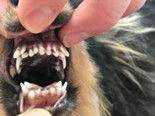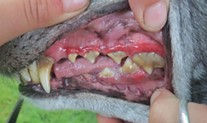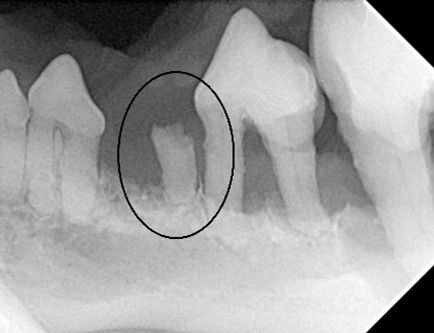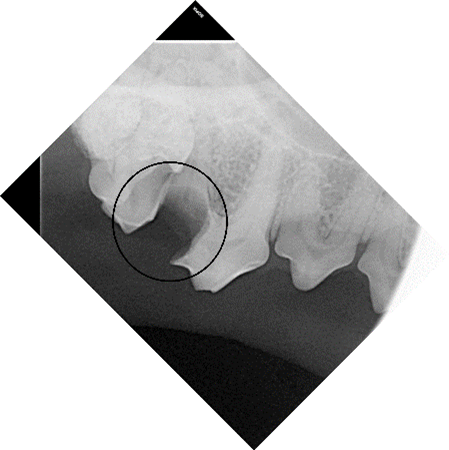The Professional Dental Cleaning with Comprehensive Oral & Radiographic Evaluation
- Dr. Elizabeth Baird

- 2 days ago
- 4 min read
A professional dental cleaning involves many steps and CORE is actually a better description of the process as it is performed in our pets. Since they do not brush and floss daily, we see advanced periodontal and dental pathology in our pets regularly.
A shocking 90% of dogs have evidence of periodontal disease by one year of age! The dogs
at the highest risk of periodontal disease should have their first professional cleaning and assessment at one year of age. Our small breed dogs, those with an adult weight of 12lbs or less, are at the highest risk for early pathology. This is likely due to both crowding of the teeth in the small jaw and to heredity factors.

Some larger breed dogs also have higher than normal periodontal disease risk and that includes Dachshunds (all sizes), Cavalier King Charles Spaniels, Greyhounds and the brachycephalic breeds like Boxers, English and French Bulldogs, Boston Terriers and Pugs.

Most other dog breeds typically have their first professional CORE procedure at the age of 3 to 5 depending on their yearly oral exam findings. Most cats fall in that same range although along with periodontal disease, they have additional problems with tooth resorption, a peculiar problem where the teeth begin to reabsorb, a very painful process. By the age of 8, most cats have at least one tooth affected by this uncomfortable, progressive disease

By addressing periodontal disease early, we can try to mitigate the problem and save teeth. If the pathology is not discovered until they have bone loss and deep periodontal pockets, the affected teeth often simply cannot be salvaged. And most importantly, those teeth are infected and painful and the dog is living with that all the while. Many pets reveal no symptoms of their dental disease to their owners. They must eat to survive, and so they soldier on even with very painful oral problems.
Twice yearly dental exams can help detect these problems before they progress to end stage teeth. Ultimately, only x-ray will reveal everything, but the dental exam during a physical often gives us many clues as to the likelihood of disease below the gum too.
A complete professional dental cleaning includes:
1) Pre-anesthetic evaluation and laboratory assessment for anesthesia
2) Individualized anesthesia and intensive monitoring by trained professional staff using state of the art monitoring equipment
3) Antiseptic pre-rinse to decrease bacterial load
4) Supra-gingival cleaning above the gumline – ultrasonic and hand scaling
5) Subgingival scaling – below the gumline – the most critical area
6) Thorough polishing of all surfaces to decrease rough spots for tartar to attach
7) Lavage of the sulcus of the gingiva to clear any debris & bacteria
8) Complete oral exam and measurement of periodontal pockets (all charted)
9) Full mouth dental radiographs (x-rays) to reveal the 60% of the tooth that isn’t visible as well as the crowns of the teeth
10) Treatment planning and therapy as indicated on the exam and radiographs
11) Application of Barrier sealant
12) Anesthetic recovery and return to owner
13) A home care plan for maintaining dental health after the professional care
The most common problems found on a CORE procedure:
Ø Periodontal disease – like people, this is very common and the infection and inflammation leads to bone loss and damage to the periodontal ligament leading to painfully loose teeth
Ø Fractured teeth – these are quite common and often the result of chewing on hard items such as antlers, cow hooves, bones, nylon toys, etc.. For cats, this is most often due to a clumsy landing and fractured front teeth. Some fractures are actually in the root below the gum and are not visible.
Ø Non-viable (or dead) teeth – also the result of chewing on hard items or forceful play or trauma to the tooth
Ø Resorptive lesions in cats causing painful exposure of the root structure (and less commonly in dogs)
Ø Dental abscesses, usually at the hidden tip of the tooth root and visible on x-ray. Many of these teeth may appear normal above the gum line.
Ø Crowded teeth that have erupted obliquely because the jaw isn’t large enough to accommodate all the teeth – this leads to damage to the adjacent teeth and dental structures.
Ø Retained Deciduous teeth (baby teeth) that never shed and cause crowding and decay of the adjacent adult teeth



Is anesthesia necessary – absolutely yes! A safe, effective cleaning and dental x-rays can only be done with general anesthesia, although it is typically a very light plane of anesthesia as compared with general surgery.
A recent study demonstrated that patients who received anesthesia-free dental procedures had more severe dental disease than those who did not have such a procedure.




Comments